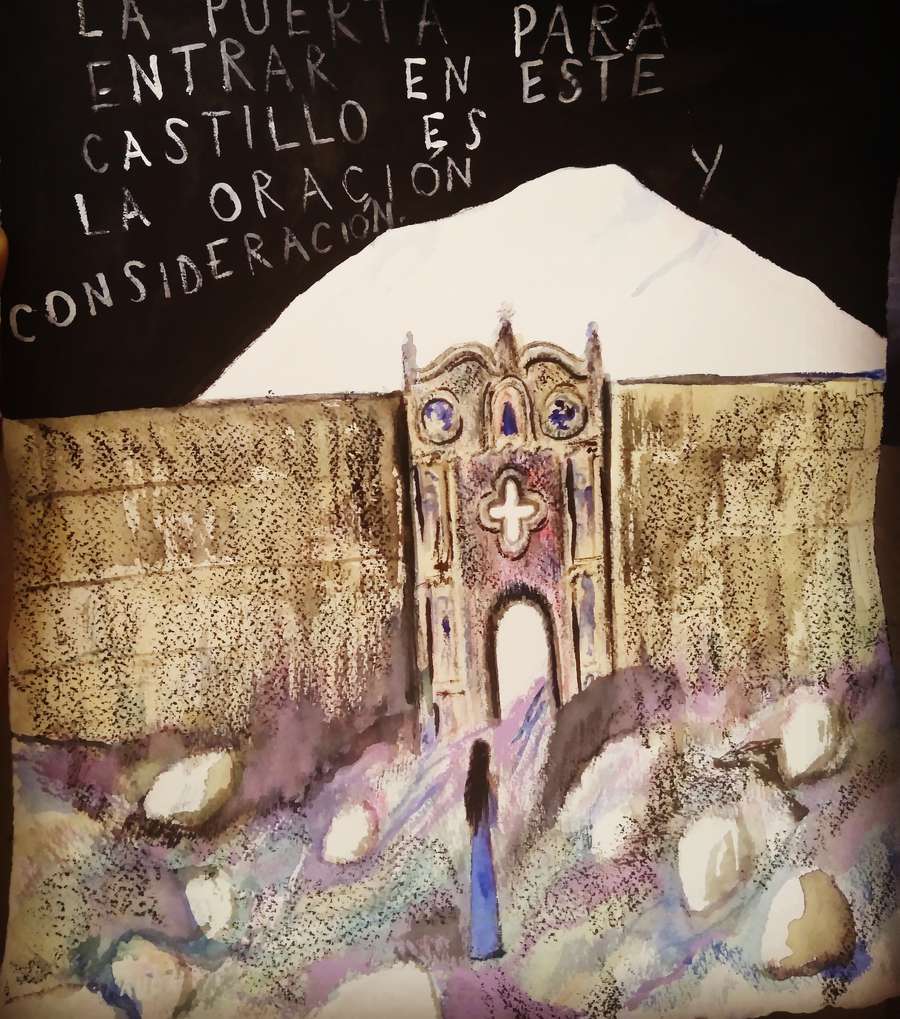Miklavž Komelj
The Endless Poet
Miklavž Komelj sees his artwork as a bridge between painting and poetry that is lined with various verses or text fragments of his own or other authors’ texts in different languages and from different periods of time.
WE LIFTED OUR HEADS UNDERNEATH THE DARK SKY
A friend of mine was surprised to see black skies in my paintings.
The closest way to describe how I see the black sky, which is also a blackboard, is with the words of Jacques Lacan in his Seminar XVIII:
“I spoke to you about stars, more exactly of constellations,
because there are stars and there are stars. The sky has been exactly this for centuries: it is the first stroke, what is above, that is important.
The sky is a plate, a blackboard. I am being reproached for using a blackboard. It is the only thing that remains to us to serve as a sky, my friends […].
I don’t know if anyone still uses a blackboard. The sky is everything that is left of the blackboard. The sky that is the blackboard.
This black carries the memory of Mangelos and his blackboards when he tried to negate the irrationality of the act of painting with the rationality of the act of writing.
Rationality? Irrationality? Is it really necessary to distinguish between the two? Both have the same relationship with this black.
Images and letters also have the same relationship with black.
In Sufism, a spiritual tradition, black denotes the transcendence of everything that is visible.
Just like nakedness has no link with any type of form.
Not only human figures, but all forms on the paintings are naked. And they cannot be any other way with regard to black.
Everything having a relationship with black is located in the same space.
It may be opposites that exclude each other anywhere else.
It may be human figures.
It may be animals.
It may be stones.
It may be altars and artefacts of ancient rituals.
It may be red flags.
It may be fire.
I grew up in a land with a dark sky, as written in one of the most festive poems honouring the country by Mira Alečković: “We lifted our heads underneath the dark sky.”
This revolutionary verse, a uniquely dense formulation of cosmic revolt, is written on this black.
And there it meets other verses and words, for instance of Juana Inés de la Cruz, Johann Wolfgang von Goethe, Jurij Dalmatin, Federico García Lorca, Jure Detela, Jakob Böhme, Alain Badiou, Pier Paolo Pasolini, Friedrich Hölderlin, Friedrich Nietzsche, Barbara Zoran, Josip Murn, Goran Trbuljak (as cited by Roman Uranjek), Sophocles, Valentin Vodnik, Seneca, the anonymous author of Liber cantionum Carniolicarum, Gérard de Nerval, Vladimir Mayakovsky, Aleksei Kruchyonykh, Kazimir Malevič, Antonin Artaud, Ezra Pound, Dante Alighieri, and my verses, too.
On this black are all the words, regardless of their author or language, as foreign as they are mine.
In one specific moment I was caught by surprise when I noticed that whenever I put the paintings together, words in various languages and voices in relation to the words and the black always connect in endless combinations to create an endless poem.
This is why I see paintings as sheets of an endless illuminated manuscript.
That are connected to the black in limitless combinations, as is everything else that is otherwise in dissonance.
All tenses run simultaneously in relation to this black.
The fundamental demand of the globalised artistic system for art today is contemporaneity. This demand is reductive in nature because the system perceives contemporaneity as a reduction to one single era, which is supposed to be ours, as opposed to all other eras.
But often it seems like the art that is trying to follow this imperative paradoxically repeats the old rather than creating something new.
This is because contemporaneity can never be con-temporaneity if it is reduced to a single era.
The true contemporaneity is only possible as the con-temporaneity of different eras blending into an expanded reality. Contemporaneity can only be found where time transforms into space.
This black is proof of that.
Miklavž Komelj, 11 January 2024
____________
1 Jacques Lacan, “O diskurzu, ki ne bi bil diskurz dozdevka”, translation Samo Tomšič and Ana Dussert, Problemi, letnik LIV, 7–8/2016, p. 16, pp. 19–20.
Miklavž Komelj was born on 10 July 1973 in Kranj. He is a poet, writer, essayist, art theorist, translator and painter.
He received his doctorate in art history on the topic of 14th century Tuscan painting. To date, Komelj has published 16 books of poetry, a novel, three short story collections, two essay collections, a scientific monograph on Partisan art, a few other books and a number of scientific articles. He also published a collection of the previously unpublished texts of Srečko Kosovel and much of Jure Detela’s and Vojko Gorjan’s literary archives. Komelj collected the correspondence of Karl Destovnik – Kajuh. He lives in Ljubljana.
Colophon
Production: Bežigrajska galerija 1 / MGML
Exhibition curator: Miloš Bašin
Artist: Miklavž Komelj
Design: Miloš Bašin
Tehnical design: Marko Tušek
Photodocumentation: Talita Sofija Komelj
Translation: Dunja Elikan
Language editing: Dunja Elikan
Promotion: Marina Mihelič Satler
Realisation of the exhibition: Miklavž Komelj, Miloš Bašin, Žoel Kastelic, Nina Medvešek, Tanja Marolt
The exhibition was made by: City of Ljubljana
Location
Dunajska 31
1000 Ljubljana
T +386 1 43 66 957
F +386 1 43 66 958
E bezigrajska.galerija1.2@gmail.com
Opening hours
Tuesday to Friday: 10:00–18:00
Saturday: 10:00–14:00
Sundays, Mondays: Closed
24 and 31 December: 10:00–14:00
1 January, 1 November, 25 December: Closed
Tickets
Free entry.
